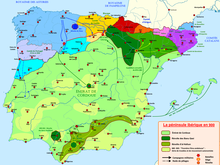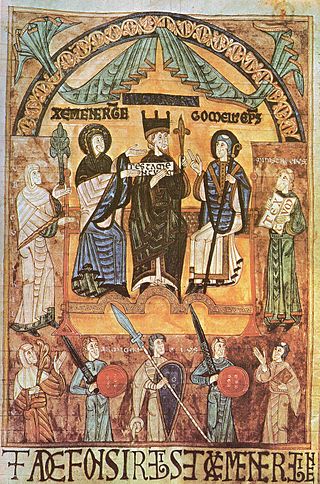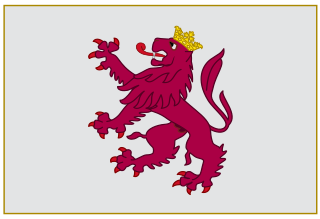Contents
This is a historical timeline of Portugal.
This is a historical timeline of Portugal.









Afonso I, also called Afonso Henriques, nicknamed the Conqueror and the Founder by the Portuguese, was the first king of Portugal. He achieved the independence of the County of Portugal, establishing a new kingdom and doubling its area with the Reconquista, an objective that he pursued until his death.

Alfonso III, called the Great, was king of Asturias from 866 until his death. He was the son and successor of Ordoño I. After his death, the Kingdom of Asturias was split between his sons, with García inheriting León, Ordoño inheriting Galicia, and Fruela inheriting Asturias.

The Kingdom of León was an independent kingdom situated in the northwest region of the Iberian Peninsula. It was founded in 910 when the Christian princes of Asturias along the northern coast of the peninsula shifted their capital from Oviedo to the city of León. The kings of León fought civil wars, wars against neighbouring kingdoms, and campaigns to repel invasions by both the Moors and the Vikings, all in order to protect their kingdom's changing fortunes.
This is a timeline of notable events during the period of Muslim presence in Iberia, starting with the Umayyad conquest in the 8th century.

Ramiro II, son of Ordoño II and Elvira Menendez, was a King of León from 931 until his death. Initially titular king only of a lesser part of the kingdom, he gained the crown of León after supplanting his brother Alfonso IV and cousin Alfonso Fróilaz in 931. The scant Anales castellanos primeros are a primary source for his reign.
This is a historical timeline of Portugal.

Ordoño II was a king of Galicia from 910, and king of Galicia and León from 914 until his death. He was an energetic ruler who submitted the kingdom of Leon to his control and fought successfully against the Muslims, who still dominated most of the Iberian Peninsula. His reign marked the tactical and smooth transition of the regnum Asturum to the regnum Legionis, with the royal headquarters already established in the city of León.

Alfonso Fróilaz, called the Hunchback, was briefly the king of the unified kingdom of Asturias, Galicia and León in 925. He succeeded his father, King Fruela II, in July 925 but was driven from the throne within the year by his cousins Sancho, Alfonso IV and Ramiro II, the sons of his uncle, Ordoño II. He was restored to a royal position in part of the kingdom after Alfonso IV took power in 926, but was violently deposed and forced into a monastery in 932.

Ordoño IV, called the Wicked or the Bad was the king of León from 958 until 960, interrupting the reign of Sancho the Fat for a two-year period.

The following is a history of Galicia, a subsection of the Iberian Peninsula.

Gonzalo Menéndez was a Count of Portugal in the Kingdom of León. He regularly carries the title count (comes), the highest in the kingdom, in surviving documents. He may have used the title magnus dux portucalensium. His name in contemporary records is usually spelled Gundisaluus Menendiz.

The County of Portugal refers to two successive medieval counties in the region around Guimarães and Porto, today corresponding to littoral northern Portugal, within which the identity of the Portuguese people formed. The first county existed from the mid-ninth to the mid-eleventh centuries as a vassalage of the Kingdom of Asturias and the Kingdom of Galicia and also part of the Kingdom of León, before being abolished as a result of rebellion. A larger entity under the same name was then reestablished in the late 11th century and subsequently elevated by its count in the mid-12th century into an independent Kingdom of Portugal.

Nuno Mendes or Nuño Menéndez was the last count of Portugal from the family of Vímara Peres. The son of Count Mendo Nunes, his desires for greater autonomy for Portugal led him to face King Garcia II of Galicia.

Mendo Nunes (Spanish: Menendo Núñez; was a Count of Portugal from the family of Vímara Peres as the son of Nuno Alvites and Ilduara Mendes.
Diogo Fernandes, was a count in the Kingdom of León whose filiation has not been documented although, from his patronymic, it is known that his father was named Fernando, and that he was possibly from Castile. He is the ancestor of many of the important 10th and 11th century noble families in the County of Portugal and in the Kingdom of León. Although the relationship has not been documented, some authors believe that Diego could have been the brother of Count Ero Fernández and of Gudesteo Fernández.

Hermenegildo Gutiérrez, was a Galician noble who lived during the 9th and 10th centuries. As the Mayordomo mayor of King Alfonso III, he was an active member of the curia regia. His daughter Elvira, as the first wife of King Ordoño II, was queen consort of León.
Garcia Moniz de Ribadouro, called the Gascon was a medieval Knight that participated in Reconquista against the Moors. He is credited with founding the Monastery of Travanca. He was the son of Munio Viegas and Válida Trocosendes de Baião, and was married to Elvira.
Elvira Menéndez was Queen consort of León due to her marriage with King Ordoño II.
Sancho Ordóñez, was a count who lived in the 11th century. His father was Ordoño Bermúdez, an illegitimate son of King Bermudo II of León, and his mother was Fronilde Peláez, also a member of the high nobility as the daughter of Count Pelayo Rodríguez and his wife Gotina Fernández de Cea, daughter of Count Fernando Bermúdez de Cea and sister of Jimena, the mother of King Sancho Garcés III the Great, and of Justa Fernández, married to Count Flaín Muñoz.